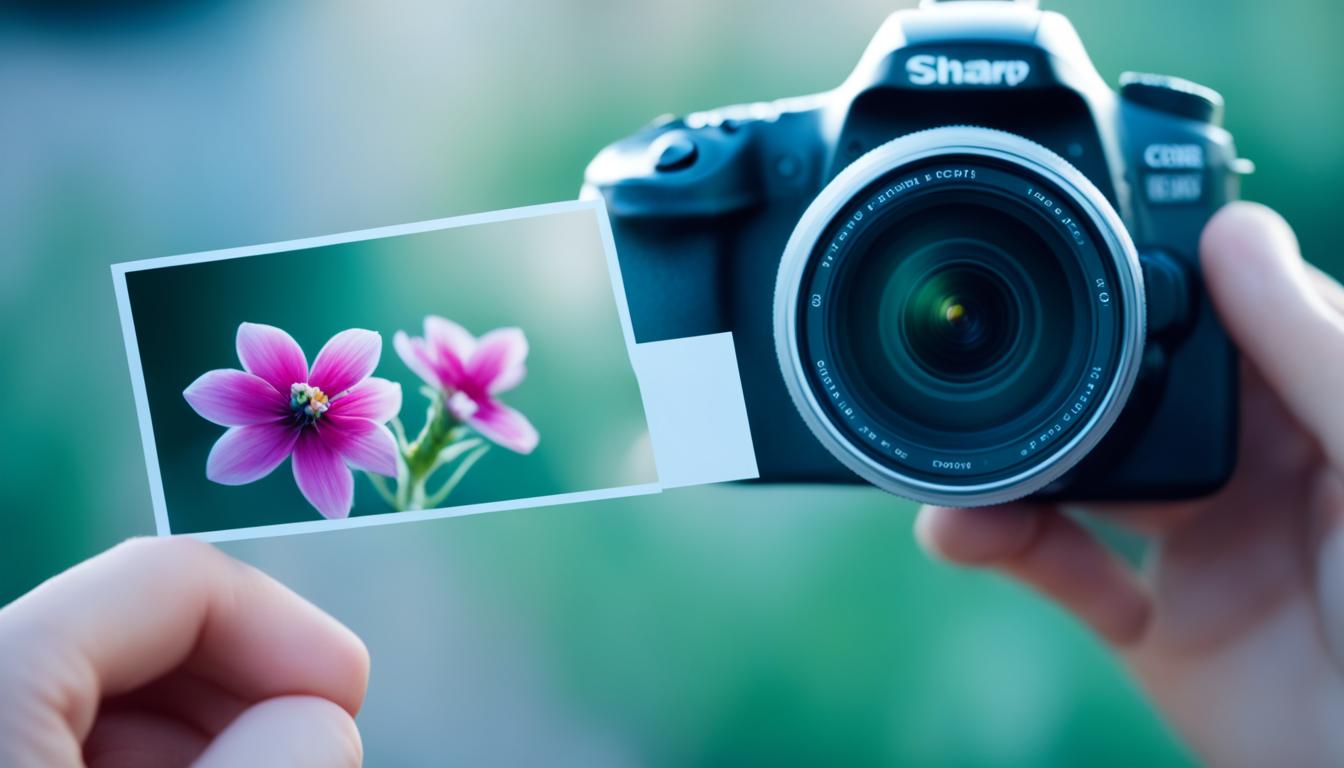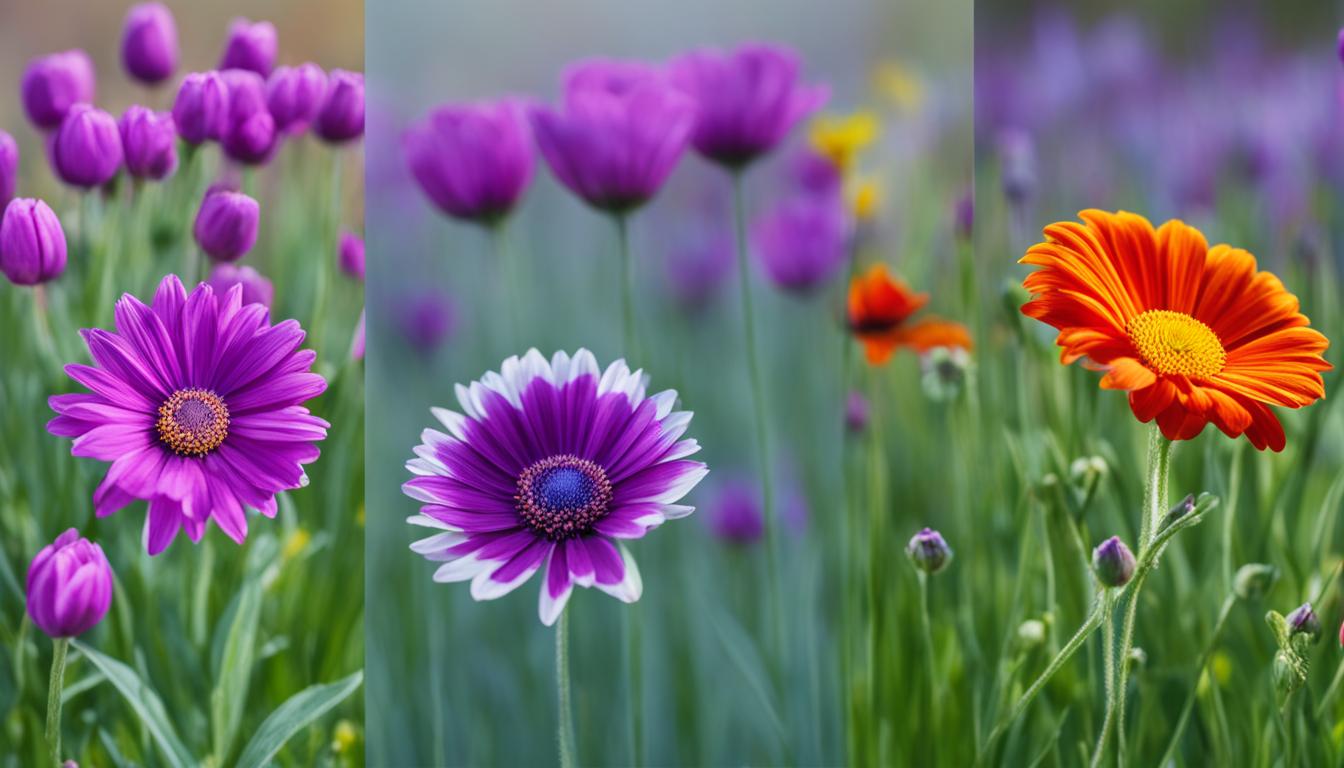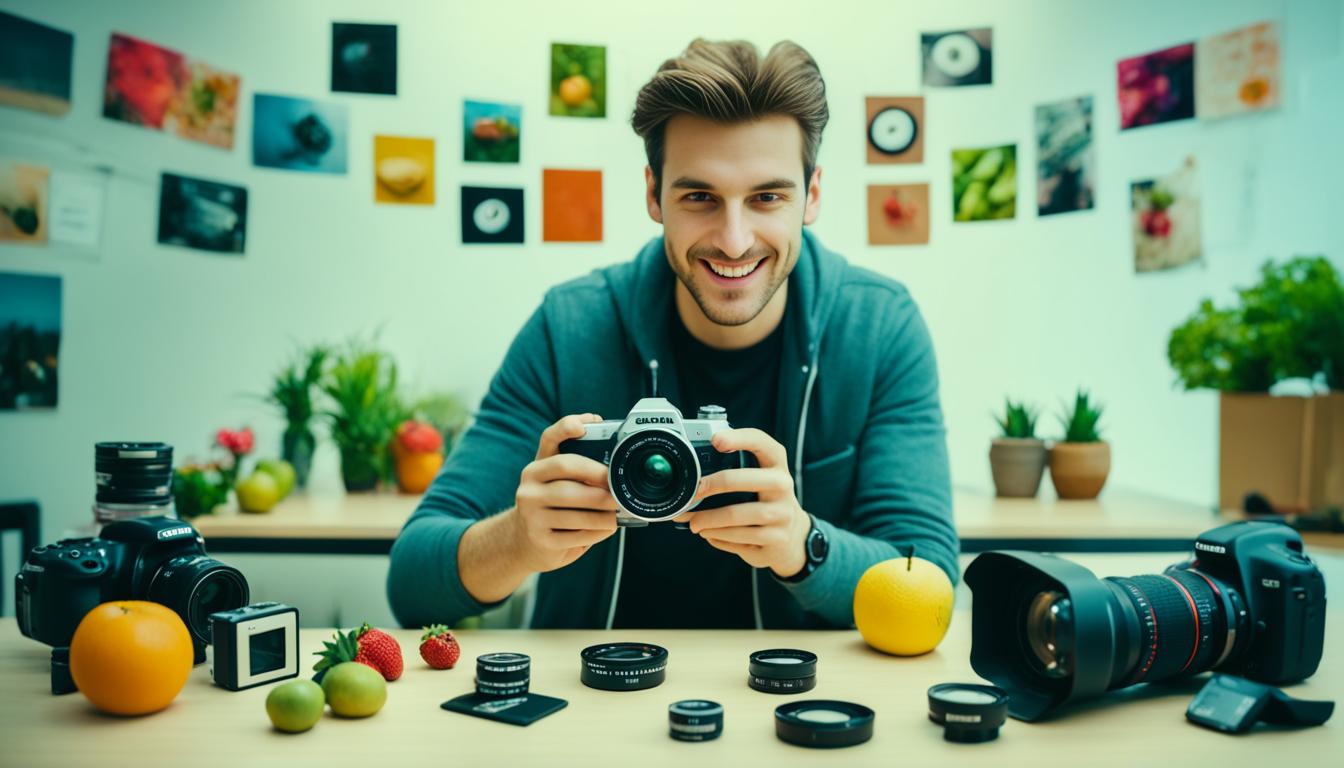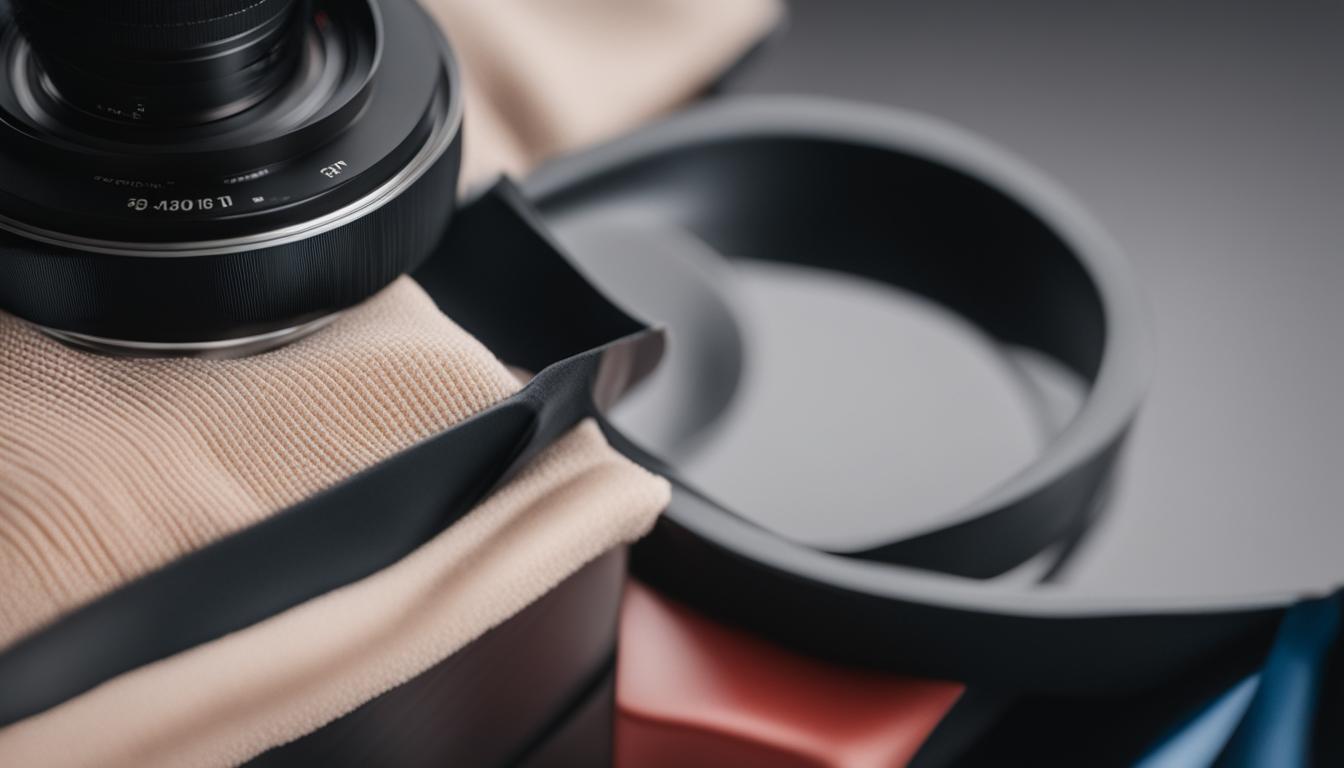In photography, achieving sharp focus is crucial for capturing eye-catching pictures. There are various techniques that can help reduce camera shake and improve image clarity. Let’s explore some of the best focusing techniques for sharp images.
Key Takeaways:
- Using the sharpest aperture enhances image sharpness
- Switching to single point autofocus ensures precise focusing
- Lowering ISO helps reduce noise and improves image clarity
- Investing in a better lens can greatly enhance image sharpness
- Removing lens filters minimizes potential image degradation
Tips for Maximum Sharpness
To achieve sharp image photography, it’s essential to apply specific techniques that enhance the overall sharpness and clarity of your photos. Here are some valuable tips and tricks that can help you achieve maximum sharpness in your images:
- Use the Sharpest Aperture: When capturing images, it’s important to choose the optimal aperture setting that produces the sharpest results. While the sharpest aperture can vary depending on the lens, it is generally recommended to use aperture values between f/8 and f/11, as these tend to offer optimal sharpness and depth of field.
- Switch to Single Point Autofocus: When focusing on a subject, using a single autofocus point instead of automatic or multi-point autofocus can significantly improve the sharpness of your images. This allows you to precisely focus on the subject and eliminate any potential focus inconsistencies caused by the camera’s autofocus system.
- Lower ISO: Higher ISO settings can introduce noise and reduce the sharpness of your photos. To achieve sharper images, it’s recommended to keep the ISO as low as possible while maintaining the desired exposure. This helps reduce digital noise and retain more detail in your images.
- Use a Better Lens: The quality of your lens plays a crucial role in achieving sharpness in photos. Investing in a high-quality lens with excellent optics can significantly improve the sharpness and overall image quality. Look for lenses known for their sharpness and clarity.
- Remove Lens Filters: While lens filters serve various purposes, they can sometimes reduce image sharpness, especially if they are of lower quality. Removing unnecessary filters when capturing critical shots can help eliminate any potential degradation and enhance overall sharpness.
- Check Sharpness on your LCD Screen: Reviewing the sharpness of your images on the camera’s LCD screen can provide immediate feedback on the image quality. Zoom in and check for any softness or lack of detail. This allows you to make any necessary adjustments to ensure maximum sharpness in your final images.
By following these simple yet effective tips, you can significantly enhance the sharpness of your photographs and achieve stunning results that captivate viewers.
Photography Tip:
The sharpness of your images is not solely determined by your camera’s settings; it is also influenced by factors such as proper technique, stable shooting conditions, and post-processing adjustments. Experimenting with different focusing techniques and incorporating these tips into your workflow can help you elevate the sharpness and overall quality of your photographs.
Improving Sharpness with a Tripod
When it comes to capturing sharp images, using a tripod is an essential tool in our photography arsenal. A tripod provides stability and helps minimize camera shake, ensuring ultimate sharpness in our photos. With the proper tripod techniques, we can take our photography to new heights.
A sturdy tripod is the foundation for achieving sharp focus. It prevents unwanted camera movement and allows us to take long exposure shots without blur. When setting up our tripod, it’s important to avoid extending the center column and legs too much, as this can introduce instability and wobbling. By keeping our tripod compact and stable, we can ensure sharpness in our shots.
Reducing vibrations is another key strategy when working with a tripod. To minimize any potential camera shake, using a remote cable release or the self-timer function on our camera can be effective. This allows us to trigger the shutter without physically touching the camera, preventing vibrations that could impact image sharpness.
For advanced tripod users looking to take their sharpness to the next level, turning off vibration reduction (also known as image stabilization) can be beneficial. While these features are useful when hand-holding the camera, they can actually introduce slight vibrations when mounted on a tripod. By deactivating vibration reduction, we can achieve even crisper images.
An additional technique for maximizing sharpness with a tripod is using mirror lock-up. When we press the shutter button, the movement of the camera’s mirror can introduce vibrations that affect image sharpness. Enabling the mirror lock-up feature on our camera lifts the mirror before taking the shot, minimizing these vibrations and resulting in sharper images.
Remember, using a tripod is an investment in the quality of our photos. It provides stability, minimizes camera shake, and allows us to achieve razor-sharp focus. Whether we’re shooting landscapes, portraits, or macro photography, incorporating a tripod into our camera focus strategies is a game-changer for capturing crystal-clear images.
| Tripod Tips |
|---|
| Choose a sturdy tripod that suits your needs. |
| Avoid extending the center column and legs too much to maintain stability. |
| Use a remote cable release or self-timer to minimize vibrations. |
| Turn off vibration reduction (image stabilization) when using a tripod. |
| Utilize mirror lock-up to reduce mirror-induced vibrations. |
Taking Sharper Photos when Hand-holding
In situations when using a tripod is not feasible, we can still achieve sharpness in our hand-held photos. Here are some techniques that can help minimize camera shake and improve the overall sharpness:
- Finding makeshift tripods: Look for objects or surfaces that can serve as a stable base for your camera. These can include walls, fences, or even your own body.
- Increasing shutter speed: Use a faster shutter speed to freeze motion and reduce the chances of camera shake. Experiment with different settings to find the optimal balance between shutter speed and exposure.
- Shooting in burst mode: Capture a series of images in rapid succession to increase the likelihood of getting a sharp shot. This technique can be particularly useful when photographing moving subjects.
- Using image stabilization: If your camera or lens has built-in image stabilization, activate it to counteract unintentional movements. This feature helps stabilize the image and can greatly improve the sharpness of hand-held photos.
- Steadying yourself: Stand with your feet shoulder-width apart and keep your upper body relaxed. This stable stance can minimize body movements that could result in camera shake.
- Gently pressing the shutter button: Avoid jerking or jabbing the shutter button when taking a photo. Instead, apply a gentle, steady pressure to minimize the risk of camera shake.
By applying these techniques, you can achieve sharper hand-held photos even without a tripod. Experiment with different combinations and settings to find the approach that works best for you.

“In situations where using a tripod isn’t possible, mastering hand-held techniques can be incredibly valuable. These tips and tricks can help you capture sharp and stunning images, no matter the circumstances.” – Photography Pro
Sharpening Photos in Editing Software
Even with careful shooting techniques, most photos can benefit from some sharpening in post-processing. When it comes to image editing, there are various tools and techniques available to enhance the sharpness and clarity of your photographs.
One popular sharpening technique is the unsharp mask. This technique works by increasing contrast along the edges of your image, creating the illusion of enhanced sharpness. By adjusting the amount, radius, and threshold settings, you can customize the level of sharpening to suit your preferences.
Other editing software options also offer powerful sharpening tools. These tools allow you to selectively sharpen specific areas of your photo or apply sharpening adjustments globally. Some software may even use advanced algorithms to intelligently enhance sharpness without introducing artifacts or noise.
When using sharpening techniques, it’s important to strike a balance between enhancing details and maintaining a natural appearance. Over-sharpened images can appear unnatural and may exhibit halos or jagged edges. It’s recommended to apply sharpening adjustments subtly and evaluate the results to ensure a pleasing outcome.
| Image Editing Software | Sharpening Techniques |
|---|---|
| Adobe Photoshop |
|
| Lightroom |
|
| GIMP |
|
Each image editing software may offer its unique set of sharpening tools and techniques. Experiment with different options and find the ones that suit your editing workflow and desired results.
Remember, sharpening is just one aspect of post-processing. It’s essential to consider other adjustments like exposure, contrast, and color balance to achieve a well-rounded image.
By utilizing the sharpening tools available in editing software and applying them judiciously, you can enhance the sharpness and clarity of your photos, resulting in more visually appealing and impactful images.
Troubleshooting Focus Issues
If you’re consistently experiencing focus issues and not getting sharp photos even after applying the techniques mentioned above, it may be necessary to troubleshoot further. The following steps can help you identify and resolve focus-related problems.
1. Cleaning the Camera’s AF Sensor and Lens Connectors
Dust particles or debris on the camera’s autofocus (AF) sensor and lens connectors can interfere with accurate focusing. Use a blower brush or a clean microfiber cloth to gently remove any dirt from these components. Be careful not to touch the sensor directly, as it is fragile and sensitive.
2. Calibrating Lenses
Sometimes, focus issues can stem from the autofocus system not aligning correctly with a specific lens. If you notice consistent misfocus with a particular lens, you can try calibrating it using your camera’s autofocus micro-adjustment feature. This process involves fine-tuning the autofocus settings to ensure accurate focus with each lens.
3. Checking Autofocus Point Accuracy
Ensure that the autofocus points on your camera are properly calibrated and accurately align with the intended focus area. You can do this by photographing a subject with multiple focus points activated and checking if the focus falls precisely where you expect it to be. If there are discrepancies, consult your camera’s manual for instructions on adjusting the autofocus settings.
4. Sending the Camera for Repair or Maintenance
If you’ve tried all the troubleshooting steps above and are still experiencing focus issues, it might be necessary to seek professional help. Contact the camera manufacturer or a reputable camera repair service to have your equipment assessed and repaired if needed. Regular maintenance can also help prevent focus-related problems in the future.

This troubleshooting guide should assist you in resolving focus issues with your camera. By following these steps, you’ll be able to capture sharper, more focused images and achieve the desired picture-perfect results.
Conclusion
In conclusion, achieving sharp images requires a combination of proper focusing techniques, shooting stability, and post-processing adjustments. By following the tips and techniques outlined in this article, you can greatly improve the sharpness and clarity of your photos.
Remember to experiment with different methods and settings to find what works best for your specific camera and shooting conditions. Each photographer has their own unique style and preferences, so it’s important to tailor these techniques to suit your needs.
With practice and attention to detail, you’ll be able to capture stunningly sharp images that truly showcase your subject’s details and enhance the overall visual impact of your photographs.
FAQ
What are some general tips for maximizing sharpness in photos?
Some general tips include using the sharpest aperture, switching to single point autofocus, lowering ISO, using a better lens, removing lens filters, and checking sharpness on your LCD screen.
How can a tripod help improve sharpness in photos?
A tripod provides stability and helps minimize camera shake. It’s important to avoid extending the center column and legs too much to prevent wobbling. Using a remote cable release or the self-timer function can also reduce vibrations. Turning off vibration reduction and using mirror lock-up can further enhance sharpness when using a tripod.
What techniques can I use to maximize sharpness when hand-holding my camera?
Some techniques include finding makeshift tripods, increasing shutter speed, shooting in burst mode, using image stabilization, steadying yourself, and gently pressing the shutter button.
How can I enhance image sharpness in post-processing?
One popular technique is the unsharp mask, which increases contrast along edges to create the illusion of sharpness. Other editing software tools and techniques can also be used to enhance sharpness and clarity.
What can I do if I’m experiencing focus issues despite using focusing techniques?
Troubleshooting steps can include cleaning the AF sensor and lens connectors, calibrating lenses, checking autofocus point accuracy, and sending the camera for repair or maintenance if necessary.
How important is it to combine focusing techniques with shooting stability and post-processing adjustments?
Achieving sharp images requires a combination of all these factors. By following the provided tips and techniques, you can greatly improve the sharpness and clarity of your photos.




